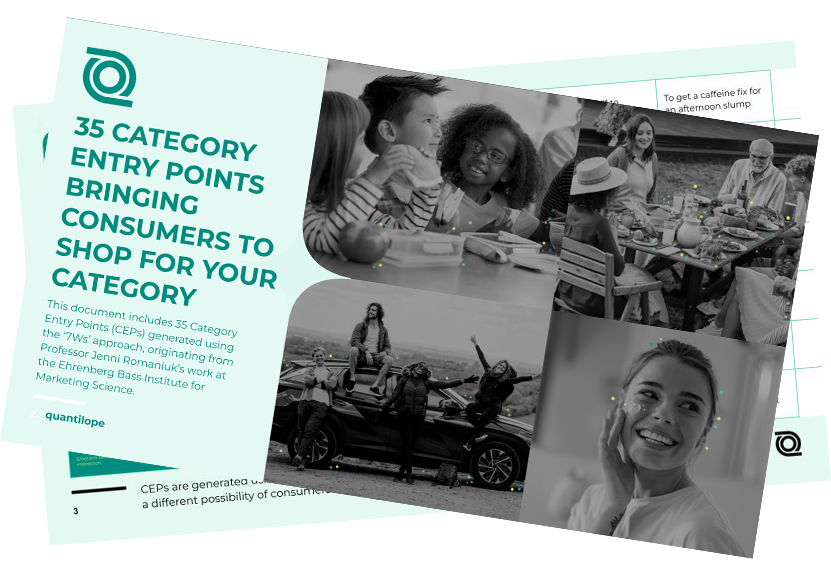Category Entry Point (CEP) Generator
Download a list of CEPs for your category!
“CEPs are very differentiating and valuable for both established and new brands. When you understand CEPs, you know how to enter the market and how to invite consumers into the category." - Joanna Katharina Lazar, CMO at Planted

Generate your Category Entry Points (CEPs)
By submitting this form, you agree to have your data processed in accordance with quantilope's Privacy Policy and to receive marketing content from us, including occasional updates, invitations, and the latest news from quantilope.
Please note: The information you provide under "Category" and "Focus Country" will be analyzed using Google's Gemini API using artificial intelligence (AI). In this course, it is possible that such data is being transferred to - and processed - on Google's servers in the United States. The mentioned fields are intended for non personal data. Any personal data you provide will be processed in accordance with data protection measures that we have implemented. Your inputs will never be used to train, fine-tune, or otherwise improve Google's AI models.
Thank You!
Your information has been successfully submitted. We'll be in touch soon!

How can I grow my brand using Category Entry Points?
CEPs are the needs, occasions, reasons, and motivations that prompt/trigger a consumer to buy from a specific product category or use a certain category's service.
Using a unique set of Category Entry Points (CEPs) generated specifically for your product category, you can gain a clear understanding of what triggers consumers to shop in your market. This approach, developed by Professors Byron Sharp and Jenni Romaniuk of the Ehrenberg-Bass Institute, uses the "7Ws" framework: Why, When, Where, While, With Who, With What, and hoW Feeling.
How can I use my Category Entry Points?
Brand leaders, marketers, and insights professionals can use CEPs to effectively increase their share of consumers, dominate their categories, and ultimately, grow their brand by:
- Optimizing brand positioning to enter a new market
- Developing key messaging in campaigns
- Inspiring promotions & point-of-sales activations
- Informing new product innovation
- Inspiring potential brand collaborations
- Track your brand performance & growth*
*CEPs are the foundation to all Better Brand Health Tracking (BBHT) efforts including Mental Availability and Mental Advantage Analysis.
quantilope automates the BBHT approach to provide real-time insights in your brand growth initatives.

"Better Brand Health Tracking has helped us to move away from a traditional readout to conversations that prompt how we view our category and can fit into consumers' minds and lives at relevant times with relevant messages."
Kelly Wade
- Director of Marketing at Florida's Natural

“BBHT is a new way of thinking about brands; it’s shifting our traditional thinking to track from a consumer perspective instead of a brand perspective.”
Amanda Cahill
- Sr. Consumer Insights Manager at Coles

“CEPs are very differentiating and valuable for both established and new brands. When you understand CEPs, you know how to enter the market and how to invite consumers into the category.”
Joanna Katharina Lazar
- CMO at Planted

Frequently Asked Questions:
What are Category Entry Points (CEPs)?
Category Entry Points (CEPs) are the mental triggers that transition consumers into potential buyers. Developed by Professors Jenni Romaniuk and Byron Sharp at the Ehrenberg-Bass Institute for Marketing Science, CEPs are the foundation to Mental Availability - a key analysis part of Better Brand Health Tracking (BBHT) that informs how readily a brand comes to mind in specific buying situations.
When consumers associate/connect a brand with multiple CEPs, it's much more likely they'll recall that brand across a variety of buying situations. This increased recall often correlates with higher sales, as consumers likely choose brands that come to mind first.
Where do CEPs come from?
Category Entry Points (CEPs) are determined by thinking through all the potential scenarios that bring consumers to your category. One approach is to follow the 7Ws - thinking about why, when, where, while, with whom, with what, and hoW consumers are feeling when interacting with your category.
Brands looking to get an initial list can use quantilope's CEP Generator (above) which provides a list of 35 CEPs for your specific category. You'd then further iterate and refine these in an Inspiration Workshop before kicking off a BBHT project.
What are some examples of CEPs in different industries?
Below are a few examples of Category Entry Points for a variety of industries:
-
Fast Food: "for a quick lunch," "on a road trip," or, "before soccer practice."
-
Face wash: "in the morning," "after a workout" or, "while showering"
-
Cleaning Products: "for spring cleaning," "when guests visit," or, "to disinfect after cooking."
quantilope's syndicated BBHT studies provide additional examples of CEPs - such as our body wash category tracker. In this study, key CEPs include "to feel fresh", "to smell nice", "after a workout", and "with a loofah, sponge, or brush".
What kind of metrics will I gain from leveraging CEPs?
By leveraging Category Entry Points (CEPs) in your BBHT study, you'll gather four key Mental Availability metrics:
1. Mental Market Share (how 'present' your brand is in consumers' minds across all CEP associations in the category)
2. Mental Penetration (the percentage of consumers who associate your brand with at least one CEP)
3. Network Size (the average number of CEPs consumers link to your brand)
4. Share of Mind (how present your brand is across all CEPs, among those who have Mental Penetration for your brand)
You'll also uncover Mental Advantages/Disadvantages (aka, where your brand performs better/worse than expected, given brand size and how 'typical' each measured attribute is to the broader category).
How can I activate CEPs in my brand strategy?
Because CEPs highlight key scenarios that 'trigger' or 'prompt' a consumer to think about a category, brands can capitalize on this by building those category associations into their branding decisions. This might include adapting product packaging to emphasize a certain CEP (e.g. "for athletes"), refining a customer loyalty program based on CEP wants/needs (e.g. "exclusive VIP perks"), partnering with influencers or brands that align with top CEPs (e.g. popular athletes for brands that are associated with "while at the gym"), or creating tailored marketing campaigns that tie to CEP associations (e.g. "for a beach vacation").
What are the common challenges when trying to implement a CEP strategy?
A common challenge is that marketers often try to link their brand to too many CEPs at once, diluting the message and making it less memorable. While it's important to have a variety of brand associations (a key Mental Availability metric known as Network Size), you still want to be strategic and thoughtful about which CEPs you go after.
Another common challenge is trying to get internal buy-in from stakeholders who are less familiar with CEPs and Better Brand Health Tracking. Many marketers and insights professionals have relied on standard brand funnel metrics for the duration of their career, making them hesitant to adopt a BBHT approach.
To see the positive impact of BBHT for real-life brands, explore our case studies with Coles and Florida's Natural.

